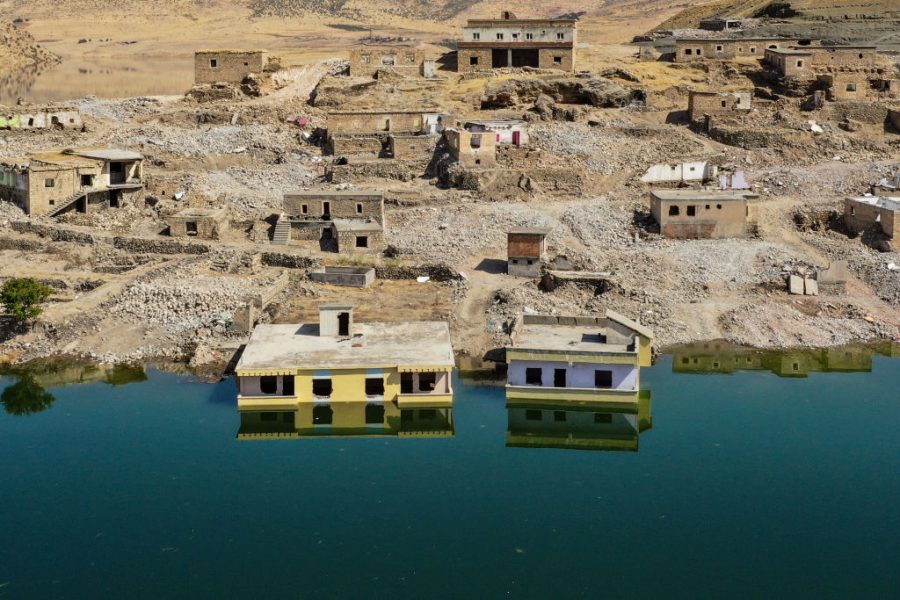
Countries across the Middle East are facing a bleak future of declining rainfall, diminishing surface- and groundwater supplies, and increasing desertification.
Since 1998, the region has faced the worst drought conditions in 900 years; it is home to 10 of the 17 countries that are currently facing ‘extremely high’ water stress. Soaring temperatures across the region—average summer temperatures are predicted to rise by 4°C by 2050 even if global rises are limited to 2°C—are increasing evaporation of surface water, forcing an over-reliance on aquifers and groundwater supplies that are already at risk of over-exploitation.
Between 2003 and 2010, parts of Turkey, Syria, Iraq and Iran along the Tigris and Euphrates river basins lost 144 cubic kilometres of total stored freshwater; 60% of that loss was attributed to the pumping of groundwater from underground reservoirs.
Given this backdrop, it’s alarming that the impact of the Middle East’s climatic conditions on water supplies is being exacerbated by dam projects that will worsen the already acute water stress and land degradation that is jeopardising agriculture across the region.
Turkey’s Southeastern Anatolia Project is one of the largest and most controversial dam-building programs globally. Twenty-two dams are slated to be constructed along the Tigris and Euphrates rivers near Turkey’s borders with Syria and Iraq. The project has attracted the ire of countries across the Middle East since its inception because of the impact it will have on critical water supplies in Turkey’s southern neighbours. In recent months Ankara has commenced filling the Ilisu Dam, the largest dam in the proposed network, further focusing attention on its actions and inflaming already tense relations with its neighbours.
Turkey’s dam and hydropower constructions on the Tigris and Euphrates are estimated to have cut water to Iraq by 80% since 1975, jeopardising agriculture and natural habitats. Iraq has also been adversely affected by dam projects and agricultural developments in Iran. As a result of declining water, desertification, salination and mismanagement, Iraq is currently losing an estimated 25,000 hectares of arable land annually, mostly in the south of the country.
Syria has also been directly impacted by Ankara’s dam-building projects, which have reduced water flows to Syria by an estimated 40%. This has been particularly problematic for Damascus, as water scarcity is more severe in Syria than in either Turkey or Iraq. The long drought that started in 2006 devastated Syria’s agriculture and forced large numbers of people into cities. It has also been linked to the social upheaval and unrest that led to the civil war in Syria. By 2011, Syria’s total annual water withdrawal as a percentage of internal renewable water resources had reached 160%, compared with 80% in Iraq and 20% in Turkey.
Iran has also criticised Turkey’s dam-building program, claiming that the Ilisu Dam poses ‘a serious environmental threat to Iraq and eventually Iran by reducing the entry of Tigris water to Iraqi territory by 56%’. Iran is facing a broader crisis in its water supplies—12 of its 31 provinces are expected to have exhausted their groundwater reserves within the next 50 years. Tehran has also predicted a decline in surface-water runoff from rainfall and snow melt of 25% by 2030. These trends make the water supplied by the Tigris even more critical to the functioning of Iran’s agriculture.
Clearly, the Middle East is facing a broad range of climatic and environmental issues, which collectively pose potentially existential challenges for the countries of the region. But the most critical problem is water security, and the transboundary Tigris–Euphrates river system is a central component of that. Turkey holds almost all of the cards on this issue: it controls 90% and 44%, respectively, of the waterflows of the Euphrates and the Tigris. Over the past 20 years or so, however, Ankara has been dismissive of demands from its neighbours for a formal water-sharing agreement to regulate the flows in the Tigris–Euphrates system.
Regional instability and political tensions arising from Turkey’s incursions into northern Syria in recent weeks make the prospect of a negotiated water-sharing agreement between Turkey and its southern neighbours remote. There’s also a risk that Ankara will ‘weaponise’ water in future disputes with its neighbours, using its control over riverine water supplies as a lever.
Turkey has been accused of ‘manipulating the present regional instability to further its agenda in the crisis-ridden Middle East, including by pursuing its ambitious plans to be a regional “water superpower” that could give it main control over the region’s waters’.
The US intelligence community’s now-dated 2012 global water security assessment noted that while water-related state-on-state conflict was unlikely within the decade to 2022, the use of water as a weapon would become more likely beyond that time frame. It also noted that ‘water problems—when combined with poverty, social tensions, environmental degradation, ineffectual leadership, and weak political institutions—contribute to social disruptions that can result in state failure’.
All of those ingredients are already apparent across the Middle East, and Turkey’s dam-building program will create further water stress, inflaming an already fragile situation. Water has featured throughout the region’s history as both a weapon of war and a trigger of conflict. In the past 60 years alone, there have been at least 25 instances in which water has been a trigger for conflict between communities and between states.
Fortunately, the last case of an actual war between states over water occurred over 4,500 years ago. But given the current environmental and climatic context and the lack of space for political and diplomatic solutions to water disputes, the Southeastern Anatolian Project may prove to be a game-changing factor.
It not only increases the risk of water-related state failure similar to what occurred in Syria, but also heightens the risk that the Middle East could move from tensions over water to actual war.

